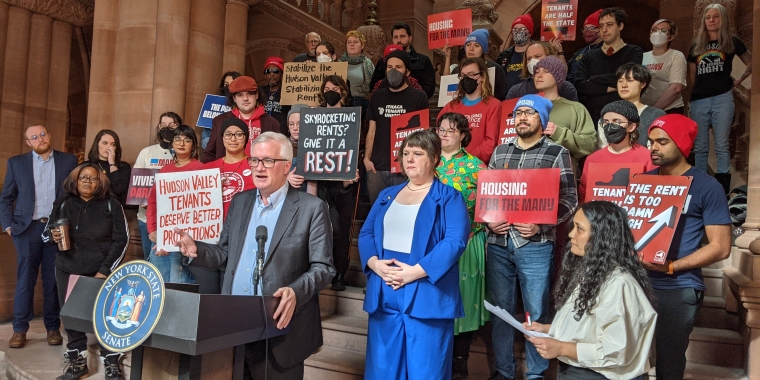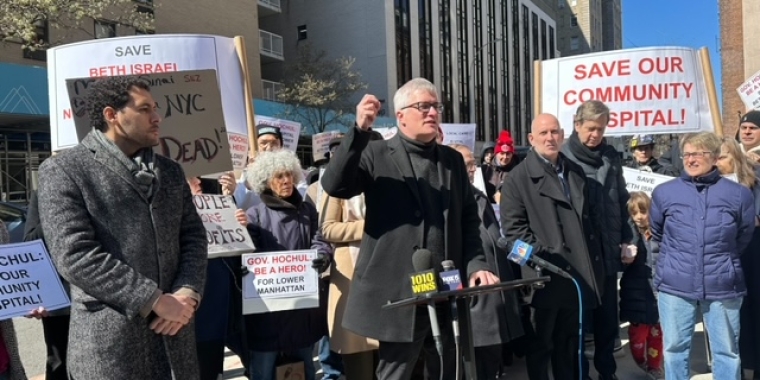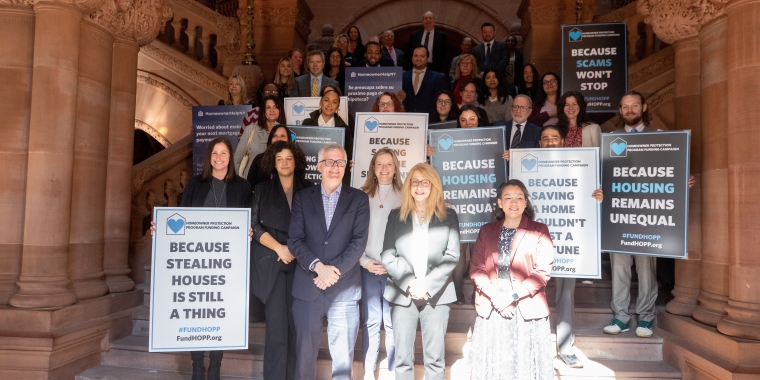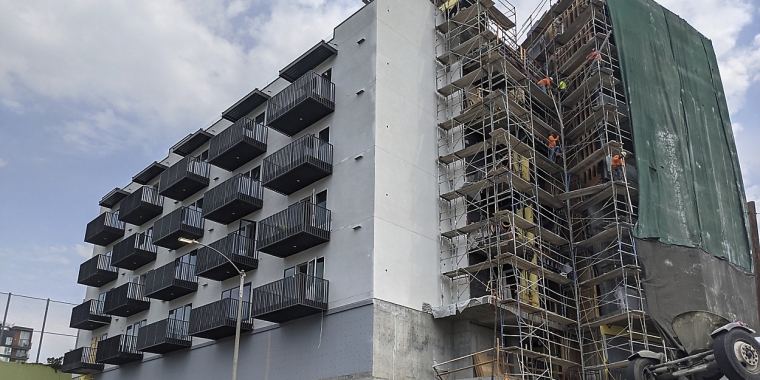
Kavanagh, Shrestha Introduce Rent Emergency Stabilization for Tenants Act S4659/A4877
February 11, 2025
-
ISSUE:
- Rent Stabilization

Albany, NY – State Senator Brian Kavanagh and Assemblymember Sarahana Shrestha were joined by legislators and housing advocates from Housing Justice for All, For the Many, and United Tenants of Albany at a press conference today to announce introduction of the Rent Emergency Stabilization for Tenants (REST) Act (S4659/A4877). The bill provides for an alternative method for localities other than New York City to opt in to rent regulation and expands the range of rental housing that can be covered.
Currently, localities must conduct a survey of rental housing they propose to regulate and demonstrate that the vacancy rate is below 5%. This bill leaves that option in place, but creates an alternative method whereby local governments would be able to consider a variety of factors in declaring a housing emergency and use publicly available data, rather than conducting their own vacancy survey. The bill would also allow localities to choose to regulate housing units in buildings with fewer than the current minimum of six units. Finally, the bill would provide that in localities that provide for rent regulation, buildings built or substantially rehabbed within the past 15 years would be exempt from rent regulation; currently under the Emergency Tenant Protection Act (ETPA), buildings built before 1974 are exempt unless they are regulated pursuant to another law or regulation.
The Rent Emergency Stabilization for Tenants Act (REST) recognizes that, in addition to vacancy rate, publicly available data on a locality’s eviction rate, homeless shelter population, renters’ housing cost burdens, and other relevant indicators can also demonstrate an inadequate supply of safe, well-maintained, stable affordable rental housing.
For example, eviction filing data in each county is available and updated monthly on the State Office of Court Administration’s Statewide Landlord Tenant Eviction Dashboard, and localities may have access to data on their local homeless shelters. These metrics can paint a fuller picture of a locality’s housing needs and can fulfill the ETPA’s requirement that localities may institute rent regulation only after declaring a housing emergency. At the same time, there may be localities that wish to declare an emergency pursuant to the existing process, based on a study of the vacancy rate; this bill leaves that process unchanged.
The ETPA in its current form extends rent stabilization to buildings with six or more units, an easy threshold to reach in high-density New York City where multifamily residential buildings are more common. Recognizing that the mix of housing varies widely across the state, this legislation would allow localities to set a lower building size threshold for rent stabilization coverage if they choose.
“Today, we are taking an important step toward empowering communities across New York State to address their unique housing challenges,” said Senator Kavanagh, Chair of the Senate Housing Committee and lead sponsor of the legislation in the Senate. “The REST Act would broaden the criteria for declaring a housing emergency, to reflect the ways in which people actually experience the housing market and the crisis that many communities face. By ensuring that local governments can respond effectively to their specific needs, we are pursuing our commitment to fostering stability and affordability for all New Yorkers.”
“The state should not come in the way of localities that want to protect their tenants,” said Assemblymember Shrestha, lead sponsor of the legislation in the Assembly. “In a district like ours in the Mid-Hudson Valley, we are losing essential community members, like fire volunteers, teachers, and home care workers, to displacement caused by housing costs. When we passed the 2019 ETPA protections, we failed to adequately consider that our state has many smaller localities that are strapped for resources, are unable to do vacancy studies and withstand prolonged lawsuits the real estate industry uses as a tool. We also have different types of housing stock that need to be covered. This bill is about empowering localities to protect themselves.”
"In my district, more than half of renters are rent-burdened or severely rent-burdened. My constituents need REST because it is not sustainable for people to continue paying more than 50% of their monthly income for housing. If we are serious about affordability, we must take action now to allow more municipalities to stabilize rents. Every corner of the state has renters, and they need the protection this bill enables," said Assemblymember Dana Levenberg.
“Tenants are half the state and need immediate solutions to the cost-of-living crisis. Families across New York are living in fear of their next rent hike because price-gouging landlords and corporate real estate developers are raising rents sky-high.” said Cea Weaver, Director of the Housing Justice for All Coalition. “By empowering local officials to stabilize rents, the REST Act will create long-term affordability in towns and cities around the state, protecting hundreds of thousands of tenants from price-gouging and displacement.”
“It’s unconscionable that upstate communities face such substantial burdens to opting into rent stabilization and protecting tenants, with thousands of households paying the price for the real estate industry’s greed each year,” said Brahvan Ranga, Political Director at For the Many. “By eliminating the vacancy study requirements for adopting ETPA and empowering local lawmakers to define for themselves what buildings are covered, the REST Act would give every New York municipality the tools to protect tenants and keep their communities safe.”
"The REST Act would give a fairer field for tenants and give a say to those of us paying the price, not just those profiting off us," said Melinda Pierce, tenant in Albany and member of United Tenants of Albany. “The vacancy study process is like trying to do a study to see if you need a Band-Aid while you're bleeding. The answer is yes: we obviously have a housing emergency.”
"By the time I was 14, I had 12 different addresses, a different bus stop every year, because that’s how often we would get evicted. The housing emergency was my reality, and it's our reality. The REST Act will allow our municipalities to confront that reality -- and protect renters from having the rent raised on them to unbearable heights and increasing homelessness in our communities," Shelby Aho, tenant in Newburgh and member of For the Many.
###
related legislation
Share this Article or Press Release
Newsroom
Go to Newsroom


